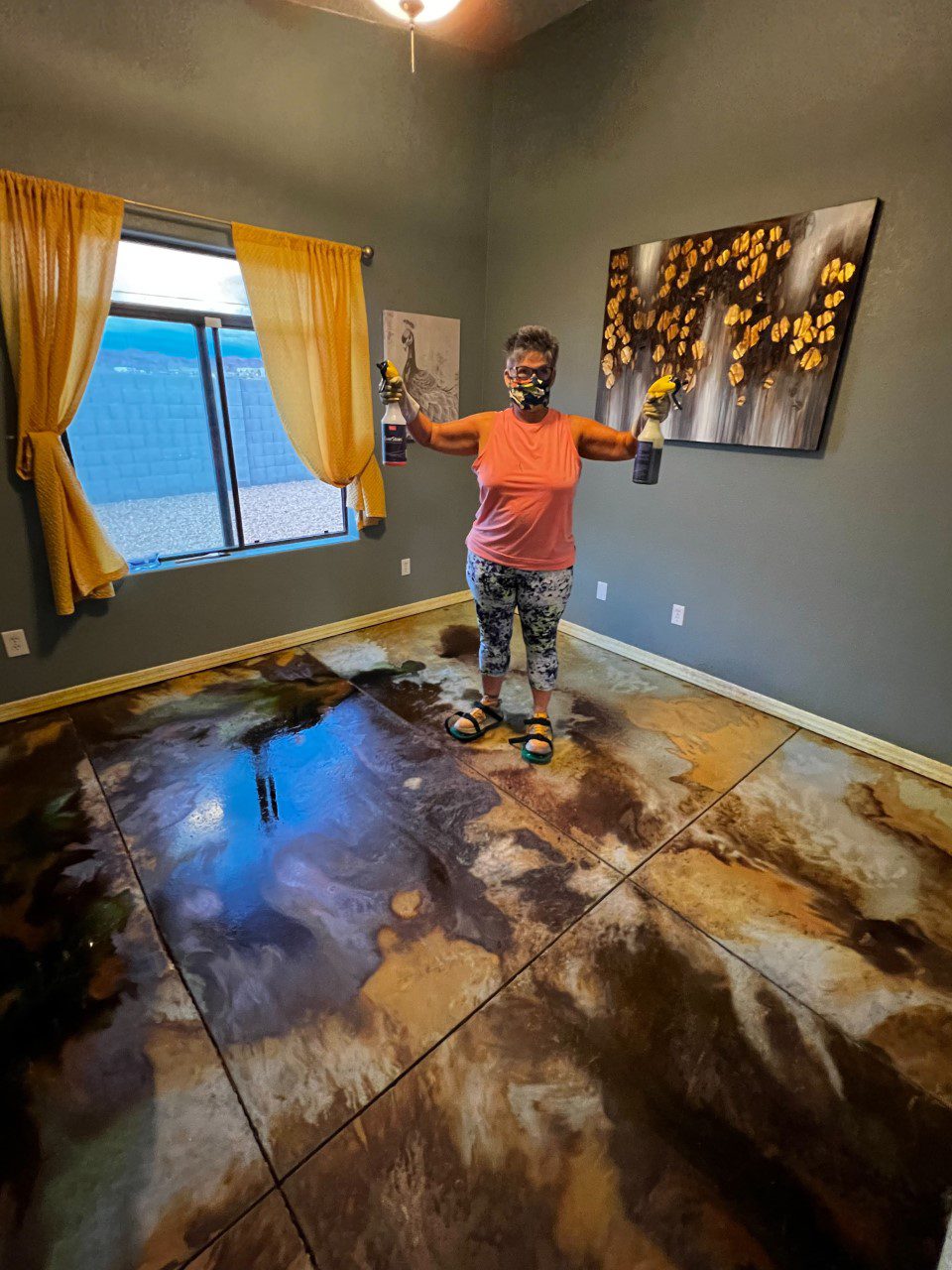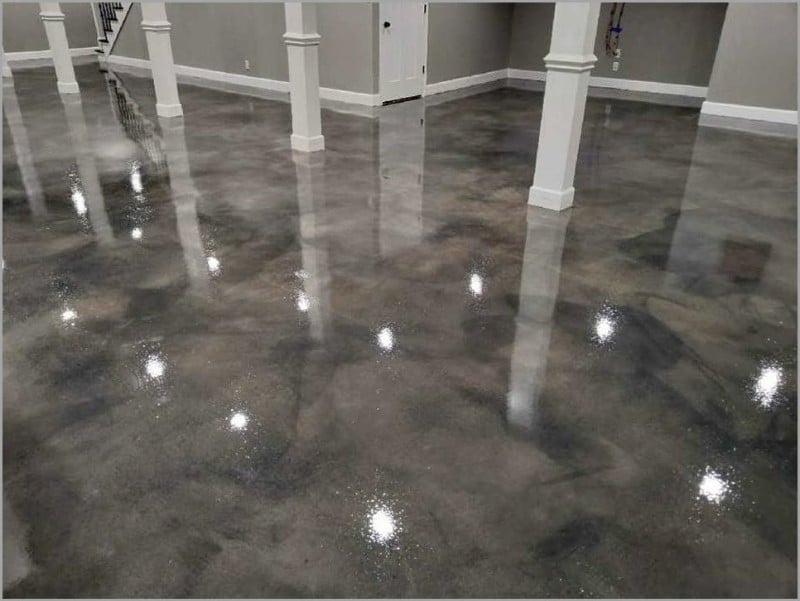The complete homeowner’s guide to austin stained concrete floors
Wiki Article
Comprehending the Various Sorts Of Stained Concrete for Your Following Job
Stained concrete offers numerous options that accommodate different visual and functional needs. Each type provides distinctive qualities that affect the last appearance and toughness of the surface area. Comprehending these differences is key for anybody planning a project. From rich, chain reactions of acid-based stains to the dynamic harmony of solid shade stains, the options can substantially impact the outcome. What elements should one think about when choosing the excellent discolor for their specific requirements?Summary of Stained Concrete
Stained concrete functions as a flexible floor covering option that can boost the visual charm of different rooms. This method entails using a coloring representative to the surface area of existing concrete, permitting a broad spectrum of layout possibilities. Stained concrete is popular in both domestic and industrial atmospheres, supplying a durable and low-maintenance service that can imitate the appearance of natural products like rock or floor tile.The staining process can be executed using water-based or solvent-based items, each giving distinct visual impacts. The final look is influenced by variables such as the original concrete surface area, the kind of tarnish utilized, and the application method. Stained concrete not only beautifies interiors and exteriors but additionally promotes sustainability by rejuvenating existing concrete structures. Because of this, it has gotten traction among homeowners and designers seeking both functionality and style in their floor covering choices.
Acid-Based Stains: Features and Benefits

One-of-a-kind Color Variants
Concrete surface areas can transform considerably with the application of acid-based stains, which offer an abundant combination of special shade variations. These stains pass through the concrete, responding chemically to produce vibrant planet tones that vary from deep browns and reds to soft eco-friendlies and blues. The resulting colors are often variegated, producing a natural, marble-like look that boosts the concrete's personality. Each application yields distinctive results as a result of variations in the concrete's composition and the staining technique used, making every job one-of-a-kind. In addition, acid-based stains can be layered or combined with other techniques to create tailored styles, allowing for personal expression. This flexibility makes acid-based stains a prominent choice for both property and commercial applications.Chain Reaction Discussed
While lots of variables add to the effectiveness of acid-based stains, the underlying chemical reactions play a vital role in their one-of-a-kind attributes and advantages. These stains mainly contain water, acid, and metallic salts. When related to concrete, the acid reacts with the calcium hydroxide in the cement, creating a chemical transformation that results in long-term color adjustments. The metallic salts permeate the surface area and bond with the concrete, enabling a vast variety of shades and tones. This response not only improves visual allure yet additionally supplies resilience, making the color resistant to fading and wear. Furthermore, acid-based stains can develop a variegated finish that resembles natural rock, more boosting their popularity for ornamental concrete applications.Surface Preparation Value
Attaining ideal results with acid-based stains depends upon detailed surface area preparation. This important action guarantees that the concrete surface area is tidy, devoid of pollutants, and correctly profiled for excellent stain absorption. Any kind of existing sealers, dust, or oils can hinder the chemical reaction that produces the preferred color and coating, resulting in irregular or patchy results.Before using the stain, the concrete ought to be mechanically cleaned or pressure washed, complied with by an extensive evaluation for splits or blemishes that may need repair service. Additionally, confirming the surface is sufficiently dried out will certainly improve stain adherence. By prioritizing these preparatory steps, the long life and vibrancy of acid-based stains can be significantly boosted, causing a more aesthetically pleasing and resilient finish.
Water-Based Stains: Functions and Benefits

Water-based stains pass through the concrete, supplying a much more clear finish that highlights the all-natural texture and variants of the surface area beneath. They are readily available in a broad anchor selection of colors, permitting creative versatility in style. Furthermore, water-based stains are easier to tidy up, calling for only water and soap, which streamlines the application procedure.
Their quick drying out time boosts performance, making them a sensible selection for both do it yourself fanatics and specialists. Overall, water-based stains offer an appealing mix of visual convenience and straightforward residential or commercial properties, making them a preferred choice for concrete enhancement tasks.
Solid Color Stains: Vibrant Options for a Bold Look
Strong color stains offer an efficient remedy for those seeking to create a bold and lively visual on concrete surfaces. These stains offer an uniform pigmentation that can significantly enhance the visual appeal of floors, patio areas, and driveways. Available in a vast spectrum of hues, strong color stains permit for creative expression, satisfying numerous layout preferences.One of the essential advantages of strong shade stains is their ability to conceal imperfections, providing a fresh and refined seek to aging concrete - Stained Concrete Austin. Additionally, their formulation generally consists of UV-resistant buildings, ensuring longevity and color retention also in harsh climate problems
Application is uncomplicated, calling for marginal prep work of the concrete surface. Once used, solid shade stains can be secured for included protection and shine, further raising their visual high quality. With their vivid alternatives, strong shade stains are a superb selection for those going for an impactful and cohesive style.
Semi-Transparent Stains: Accomplishing Depth and Measurement
Semi-transparent stains offer an one-of-a-kind approach to boosting concrete surface areas by providing deepness and dimension via numerous shade alternatives. Understanding the application techniques is vital for achieving the preferred result, while appropriate upkeep practices guarantee durability. This area will discover these crucial aspects to make the most of the advantages of semi-transparent this page staining.Color Options Available
A variety of shade options exists for semi-transparent stains, allowing homeowners and designers to boost the all-natural elegance of concrete surface areas. These stains can be found in a selection of hues, from natural tones like browns and terracottas to vibrant shades such as blues and eco-friendlies. The semi-transparent nature of these stains allows the underlying concrete to show through, developing a special depth and dimension that can match numerous design aesthetics. Additionally, combining various shades can create customized tones, allowing a customized search for each job. This versatility makes semi-transparent stains a popular option for both exterior and interior applications, as they can balance with surrounding components while adding visual rate of interest to ordinary concrete.Application Methods Described
To accomplish the wanted deepness and dimension with semi-transparent stains, correct application techniques are important. Initially, surface preparation is crucial; the concrete has to be tidy and devoid of any type of pollutants. This usually entails power cleaning and fixing any type of splits. Next off, choosing the best applicator, such as a sprayer, roller, or brush, can influence the final look. Sprayers enable for an extra even application, while rollers can help attain texture. It is essential to apply the stain in slim, even layers, allowing each layer to dry prior to adding an additional. Adjusting the application strategy, such as differing stress or using different tools, can develop unique impacts. Ultimately, securing the stained surface area boosts the vibrancy of the colors while providing security.Upkeep Best Practices
Regular maintenance is necessary for preserving the elegance and stability of surface areas treated with semi-transparent stains. To preserve these surface areas, routine cleaning is essential. Making use of a pH-neutral cleaner and a soft-bristle mop will certainly help remove dirt and debris without damaging the stain. It is suggested to prevent extreme chemicals, as they can deteriorate the stain's look. Furthermore, regular resealing every one to 3 years can safeguard versus wear and fading. This process entails cleansing the surface completely and applying a compatible sealant you could look here designed for stained concrete. House owners need to also monitor for any kind of indications of discoloration or damage and address these concerns promptly to ensure resilient vibrancy and longevity. Following these finest techniques will certainly enhance the total lifespan of semi-transparent stained surfaces.Results and Techniques: Personalizing Your Stained Concrete
Customizing stained concrete includes a variety of strategies that enhance both aesthetics and performance. Among these methods, layering different discolor shades can develop depth and complexity, enabling one-of-a-kind aesthetic impacts. Techniques such as acid discoloration provide a variegated appearance, while water-based stains supply a more uniform look.Furthermore, integrating attractive patterns, such as stenciling or engraving, can better customize the surface, including intricate designs that deal with private preferences. Texturing the concrete, whether with stamping or mop finishes, introduces tactile components that not just improve hold however likewise improve aesthetic interest.
Using sealants can intensify the color vibrancy and give defense against wear. Customization methods expand past mere color; they can change a conventional concrete slab right into a spectacular focal factor, making it appropriate for both residential and commercial rooms. Via cautious selection of results and methods, stained concrete can accomplish a truly customized look.
Upkeep and Longevity of Stained Surfaces
Stained concrete surface areas are recognized for their longevity and aesthetic appeal, preserving their honesty is essential for guaranteeing long life. Routine cleansing is essential; sweeping and mopping with a pH-neutral cleaner aids protect against dust accumulation and staining. Additionally, applying a sealer every couple of years can shield the surface from dampness, chemicals, and UV damage, therefore enhancing its lifespan.It is likewise vital to deal with any kind of fractures or chips promptly. Little repair work can mitigate more deterioration, maintaining the aesthetic and architectural top quality of the surface area. For exterior stained concrete, seasonal maintenance, such as removing snow and ice, is necessary to avoid surface area damage from freeze-thaw cycles.
Often Asked Concerns
Can I Discolor Existing Concrete Surfaces or Brand-new Ones?
The question of whether existing concrete surfaces can be stained emerges often. It is indeed possible to discolor both new and old concrete, supplied the surface area is sufficiently prepared and devoid of pollutants for perfect bond.How much time Does the Discoloration Refine Generally Take?
The staining procedure usually takes one to three days, relying on aspects such as surface area preparation, sort of stain, and weather. Austin Stained Concrete Floors. Curing time may extend past first application, influencing the overall duration substantiallyIs Stained Concrete Safe for Outdoor Usage?
Stained concrete is normally safe for outside usage, offered it is properly sealed. This securing protects versus wetness and UV damage, making sure toughness and safety, while also improving the aesthetic allure of outside rooms.Can I Use Multiple Discoloration Layers for Various Impacts?
Using several stain layers can achieve diverse results on stained concrete. It is vital to assure compatibility in between stains and permit appropriate drying out time in between applications to prevent unexpected reactions or discoloration.Are There Any Type Of Shade Limitations for Stained Concrete?
Shade limitations for stained concrete mainly depend on the kind of tarnish used, with water-based stains using a wider scheme compared to acid-based stains. Stained Concrete Floors Austin. Attaining vibrant colors might need careful selection and application methods.Report this wiki page